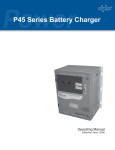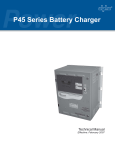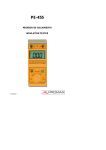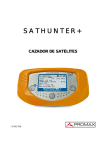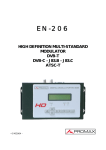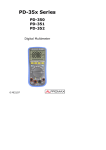Download Manual de instrucciones bilingüe (Español e Inglés)
Transcript
PE-425 ANALIZADOR DE REDES ELÉCTRICAS (IMPEDANCIA DE TIERRA, BUCLE y CORTOCIRCUITO) ELECTRICAL MULTIFUNCTION NETWORK ANALYZER (LOOP, PSC and EARTH TESTER) - 0 MI1316 - NOTAS SOBRE SEGURIDAD Antes de manipular el equipo leer el manual de instrucciones y muy especialmente el apartado PRESCRIPCIONES DE SEGURIDAD. sobre el equipo significa "CONSULTAR EL MANUAL DE El símbolo INSTRUCCIONES". En este manual puede aparecer también como símbolo de advertencia o precaución. Recuadros de ADVERTENCIAS Y PRECAUCIONES pueden aparecer a lo largo de este manual para evitar riesgos de accidentes a personas o daños al equipo u otras propiedades. SAFETY NOTES Read the user’s manual before using the equipment, mainly " SAFETY RULES " paragraph. The symbol on the equipment means "SEE USER’S MANUAL". In this manual may also appear as a Caution or Warning symbol. Warning and Caution statements may appear in this manual to avoid injury hazard or damage to this product or other property. SUMARIO CONTENTS English Manual español................................................................................ English manual ................................................................................ MANUAL DE INSTRUCCIONES. PE-425 ÍNDICE 1. GENERAL.................................................................................................................. 1 1.1 Características .................................................................................................... 1 1.2 Especificaciones.................................................................................................. 2 2. PRESCRIPCIONES DE SEGURIDAD ...................................................................... 3 2.1 Generales............................................................................................................ 3 2.2 Ejemplos Descriptivos de las Categorías de Sobretensión ................................ 4 3. DESCRIPCIÓN DEL PRODUCTO ............................................................................ 5 3.1 Descripción.......................................................................................................... 5 3.2 Conexiones ......................................................................................................... 8 3.3 Preparación para la utilización .......................................................................... 10 3.4 Análisis de Redes Eléctricas y Fallos................................................................ 11 4. MANTENIMIENTO................................................................................................... 15 4.1 Sustitución de la pila ......................................................................................... 15 4.2 Limpieza y almacenamiento.............................................................................. 15 MANUAL DE INSTRUCCIONES. PE-425 MANUAL DE INSTRUCCIONES. PE-425 ANALIZADOR DE REDES ELÉCTRICAS (IMPEDANCIA DE TIERRA, BUCLE y CORTOCIRCUITO) PE-425 1. GENERAL 1.1 Características • • Incorpora una función para la comprobación de la impedancia de Tierra. Comprobación de la impedancia de Bucle y de Probable Corriente de Cortocircuito (PCC). De 0,03 a 2000Ω (Control por microprocesador). • Voltímetro integrado • Indicadores conexionado correcto. • Operación mediante un único botón multifunción. • Visualiza tensiones L-N y L-E. De 50 a 275 V AC (Sinusoidales). • Visualiza la impedancia de Línea. De 0,03 a 2000Ω (Control por microprocesador). • Visualiza la impedancia de Tierra. De 0,03 a 2000Ω (Control por microprocesador). • Visualiza la impedancia de Neutro. De 0,03 a 2000Ω (Control por microprocesador). • • Visualiza la PCC de Línea a Neutro. Hasta 6kA para tensiones de funcionamiento de 230 Vac. Visualiza la PCC de Línea a Tierra. Hasta 6kA para tensiones de funcionamiento de 230 Vac. • Permite desplazar la visualización hasta los resultados anteriores (Scroll). • Indicador de batería OK / Baja. • Función autodesconexión (tiempo a la desconexión: 5 minutos). • Puntas de prueba codificadas en colores. • Chasis resistente. • Consumo muy bajo. 05/2015 Página 1 MANUAL DE INSTRUCCIONES. PE-425 1.2 Especificaciones Bucles / Tierra / Cableados 0.03 — 2000 Ω autorrango Probable Corriente Cortocircuito 0 — 6 kA para 230 V AC Tensión de funcionamiento 50-275 V AC (sólo 50 Hz) Tensión óptima de funcionamiento 230 V AC ±20% Máx. 10A Precisión de Tensiones ± 1% (210-250V) ± 3% en otro caso. Precisión en impedancias de Bucle / Tierra y Cableados > 2% Alimentación Baterías (6 x 1,5V tipo R6) Dimensiones 90 (A) x 205 (Al) x 55 (Pr) mm Peso 535 grs. Baterías incluidas NOTA: Las especificaciones del equipo se establecen en las siguientes condiciones ambientales de operación, siendo también posible su operación fuera de esos márgenes. Por favor consulte con nosotros en el caso que fueran necesarios requerimientos específicos. Condiciones ambientales de funcionamiento Altitud Hasta 2000 m Escala de temperatura De 0 a 40 °C Máx. Humedad relativa 85% Temperatura Almacenamiento 20 °C a -60 °C Accesorios incluidos PP011 Conjunto de tres puntas de prueba pinzabanana de seguridad Manual de instrucciones Maleta de transporte RECOMENDACIONES ACERCA DEL EMBALAJE Se recomienda guardar todo el material de embalaje de forma permanente por si fuera necesario retornar el equipo al Servicio de Asistencia Técnica. Página 2 05/2015 MANUAL DE INSTRUCCIONES. PE-425 2. PRESCRIPCIONES DE SEGURIDAD 2.1 Generales * Este equipo puede ser utilizado en instalaciones con Categoría de Sobretensión III y ambientes con Grado de Polución 2 (Ver 2.2). * Al emplear cualquiera de los siguientes accesorios debe hacerse solo con los tipos especificados a fin de preservar la seguridad. Puntas de prueba * Revisar el estado de las puntas de prueba antes de su utilización. * Tener siempre en cuenta los márgenes especificados tanto para la alimentación como para la medida. * Recuerde que las tensiones superiores a 60 V DC ó 30 V AC rms son potencialmente peligrosas. * Observar en todo momento especificadas para el aparato. * El operador sólo está autorizado a intervenir en: las condiciones ambientales máximas Sustitución de la pila. En el apartado de Mantenimiento se dan instrucciones específicas para estas intervenciones. Cualquier otro cambio en el equipo deberá ser efectuado exclusivamente por personal especializado. * Seguir estrictamente las recomendaciones de limpieza que se describen en el apartado Mantenimiento. 05/2015 Página 3 MANUAL DE INSTRUCCIONES. PE-425 * Símbolos relacionados con la seguridad: 2.2 Ejemplos Descriptivos de las Categorías de Sobretensión Cat I Instalaciones de baja tensión separadas de la red. Cat II Instalaciones domésticas móviles. Cat III Instalaciones domésticas fijas. Cat IV Instalaciones industriales. Página 4 05/2015 MANUAL DE INSTRUCCIONES. PE-425 3. DESCRIPCIÓN DEL PRODUCTO 3.1 Descripción El analizador de redes eléctricas de Baja Tensión PE-425, consta de dos dispositivos internos de inyección de corriente, así como circuitos para la medida de la tensión, la corriente y un microprocesador de control conectado a la pantalla gráfica. Cada vez que el usuario pulsa el botón, la potencia se aplica al circuito bajo prueba. El analizador PE-425 representa un nuevo tipo de instrumento multifunción destinado a la comprobación y recopilación de datos de todos los componentes importantes que intervienen en una instalación eléctrica básica. Hasta ahora para poder analizar una red eléctrica o localizar un fallo rápidamente, era necesario adquirir instrumentos muy costosos y voluminosos. La avanzada tecnología del analizador PE-425 de PROMAX resuelve este problema. Además incorpora un indicador luminoso para la comprobación del cableado correcto de los circuitos eléctricos bajo prueba. Las funciones de este microprocesador se controlan mediante un único botón multifunción. Pulsándolo una vez, se pone en funcionamiento el instrumento, con otra pulsación se inicia el TEST, si se pulsa de nuevo permite desplazarse a través de los resultados obtenidos (SCROLL) o visualizar anteriores lecturas, finalmente se puede pulsar para inciar (START) otro test. El PE-425 resulta tan simple de utilizar que el técnico puede concentrarse en la resolución del problema eléctrico sin necesidad de dedicarle excesivo tiempo al estudio del manual de instrucciones. Este analizador de redes eléctricas se basa en la inyección de altas corrientes en múltiples líneas de forma que los valores resultantes no se vean afectados por la presencia de ruido en la red siendo la corriente inyectada de valor próximo a la realidad. El instrumento medirá primero la tensión del suministrador de fluido eléctrico (compañía suministradora) en el origen (VG). Una corriente elevada se inyecta entre la Línea y el Neutro desde el punto donde se realiza el test. Todos los resultados obtenidos (tensiones y corrientes) de este punto de medida se almacenan en una memoria RAM del microprocesador. Después otra corriente elevada se inyecta entre la Línea y Tierra desde el mismo punto (de forma totalmente automática, sin intervención del usuario), las corrientes y tensiones son de nuevo medidas y almacenadas. A partir de ese momento el microprocesador dispone de suficiente información para procesar todos los resultados y visualizarlos. 05/2015 Página 5 MANUAL DE INSTRUCCIONES. PE-425 Con el PE-425, el técnico en electricidad puede verificar rápidamente si el estado de la red es correcto o si presenta algún problema en el circuito de Línea, Neutro o Tierra. Además el circuito de Tierra es verificado sin necesidad de utilizar picas o cables largos. El circuito de Tierra que comprueba el analizador se corresponde exactamente con el recorrido por la corriente de tierra. De esta forma se obtienen precisas medidas de la Probable Corriente de Cortocircuito (PCC) y de la impedancia de bucle entre Línea y Neutro y Línea y Tierra, mostrando todos los componentes que intervienen. El PE-425 es el primer analizador de redes eléctricas portátil. Es muy útil para la localización de fallos o la puesta en servicio de instalaciones eléctricas de Baja Tensión. La separación de los circuitos de Línea (activo), Neutro y Tierra (masa) mediante la lectura de los valores asociados resulta muy sencillo. Defectos de contacto, cableados antiguos o circuitos de Tierra defectuosos son identificados rápidamente. Los fallos eléctricos se resuelven en tan sólo una fracción del tiempo que se necesitaría utilizando los intrumentos convencionales. Permite reducir la duración de la avería de forma que el fallo puede ser identificado y diagnosticado rápidamente. Permite identificar fácilmente los cables que deben ser sustituidos (cables que presentan impedancias muy elevadas antes de provocar un riesgo de incendio). Al disponer de un comprobador de bucles de impedancia y de Probable Corriente de Cortocircuito integrado, así como un voltímetro facilita el análisis completo de la red eléctrica, desplazándose por los resultados obtenidos. Página 6 05/2015 MANUAL DE INSTRUCCIONES. PE-425 (1) (2) (3) (5) (4) Figure 1.- Descripción del equipo 1. Conectores. 2. Pantalla de cristal líquido (LCD). 3. Indicador (LED) de conexionado correcto. 4. Indicador (LED) de conexionado incorrecto. 5. On, Test, Scroll, menú.,. (BOTÓN MULTIFUNCIÓN) 05/2015 Página 7 MANUAL DE INSTRUCCIONES. PE-425 Transformador de la compañia suministradora 3.2 Conexiones Localización de fallos y análisis de la red eléctrica Circuito de Línea (activo) completo incluyendo el transformador ZL L Segmento de usuario, futuras cargas, puntos de test, conectores de distribución, etc.,. VL-N VG ZN N PSCL-N PSC L-N PSCL-E VL-E ZE Suministro eléctrico y distribución PSCL-E E Puntos de test o conectores de distribución VG = Tensión del generador (transformador de alimentación) (impedancia interna del transformador = X-Form) ZL = Impedancia del cable de Línea desde el transformador hasta el punto de test (ZL medida por el instrumento también incluye la X-Form). Si esta impedancia es muy elevada, verificar las conexiones del cableado de Línea, la calidad del cableado de la línea y los derivadores y contactos presentes en el circuito de Línea. ZN = Impedancia del cable Neutro desde el transformador hasta el punto de test. Si esta impedancia es muy elevada, verificar las conexiones del cableado de Neutro, la calidad del cableado de la línea y los derivados y contactos presentes en el circuito del Neutro.. ZE = Impedancia del cable de Tierra incluyendo la impedancia de Tierra en sí misma, representado la protección del sistema. Se debe verificar con una especial atención en los puntos de unión en el caso de obtener medidas de impedancia muy elevadas.. ZL=Impedancia del cable de Línea (activo) incluida la impedancia del transformador. ZN=Impedancia del cable Neutro. ZE=Impedancia de Tierra (Masa) incluidas todas las conexiones. PSCL-E, PSCL-N= Probable corriente de cortocircuito (L a N) y (L a E). VG=Transformador de tensión de alimentación de redes eléctricas (sin carga). VL-N, VL-E=Tensión entre L-N y L-E (sin carga). Nota importante: La precisión del instrumento depende de la estabilidad de VG mientras mide. Figura 2.- Esquema de la red eléctrica Página 8 05/2015 MANUAL DE INSTRUCCIONES. PE-425 El instrumento mide : • Tensión AC Línea - Tierra • Impedancia de bucle Línea - Tierra • Probable Corriente de Cortocircuito L-E (Esta es la corriente que se generaría entre el circuito de Línea y el de Tierra en caso de producirse un cortocircuito entre ambos circuitos) • Tensión AC Línea - Neutro • Impedancia Línea - Neutro • Probable Corriente de Cortocircuito L-N (Esta es la corriente que se generaría entre el circuito de Línea y el Neutro en caso de producirse un cortocircuito entre ambos circuitos) • Impedancia de la pica de Tierra (cable de Tierra) • Impedancia de Línea + Transformador (X-Form) • Impedancia del cable del Neutro • Integridad del cableado Datos recopilados por el instrumento: • Indicación batería baja • Conexionado defectuoso • No hay tension de línea • Sobre-temperatura. Figura 3.- Conexiones del instrumento 05/2015 Página 9 MANUAL DE INSTRUCCIONES. PE-425 3.3 Preparación para la utilización • Al desembalar el equipo debe ser inspeccionado para descartar daños visibles. Las puntas de prueba deben ser verificadas por si presentan roturas, fallos de continuidad o cualquier daño. No utilizar el equipo con las puntas de prueba dañadas. Pulsar el botón ON y asegúrarse que las baterías están en buenas condiciones (aparece indicado battery low en la pantalla y el indicador luminoso BAT OK no se enciende si las baterías necesitan ser sustituidas). ANTES DE INICIAR UN TEST SE DEBEN COMPROBAR LOS SIGUIENTES PUNTOS: • Todos los interruptores diferenciales (RCD’s) deben de estar punteados durante la duración del test. ATENCIÓN: Por seguridad, asegurarse que no hay personal ajeno usando la instalación. ATENCIÓN: Una vez acabado el test, volver a conectar los RCD’s para no dejar la instalación sin protección eléctrica. • Para evitar medidas erróneas y averías, es necesario desconectar todos los equipos de carga de la instalación. • Realizar un pequeño esquema de la instalación a testear para comprobar que los resultados son acordes a dicha instalación. Página 10 05/2015 MANUAL DE INSTRUCCIONES. PE-425 3.4 Análisis de Redes Eléctricas y Fallos Conexión del medidor Después de conectar las puntas de prueba al circuito bajo test y antes de iniciar la lectura, compruebe en el medidor que la conexión es correcta verificando que el indicador LED rojo N-E está apagado y los indicadores LED verdes L-N, L-E están encendidos. Pantalla inicial Conectar puntas de prueba Pulsar ON/TEST 1 Mensaje de “No Conexión” NO ¿Medidor Conectado? SI Pulsar ON/TEST Inicio de Test automático ¿Existe Medida anterior? NO SI Tensión entre Línea-Neutro Recuperación de las anteriores medidas Desconectar puntas de prueba Pulsar ON/TEST SI Pulsar ON/TEST ¿Medidor Desconectado? NO Tensión AC entre Línea y Tierra Tensión entre Línea-Neutro Pulsar ON/TEST 1 NOTA: Si lo que se desea es visualizar los resultados de un test anterior, no conecte las puntas de prueba al circuito bajo test. 05/2015 Página 11 MANUAL DE INSTRUCCIONES. PE-425 Pulsar ON/TEST Impedancia de bucle Línea-Tierra Pulsar ON/TEST Impedancia de bucle Línea-Neutro Pulsar ON/TEST Probable corriente de Cortocircuito Línea-Neutro Esta es la corriente que se generaría entre el circuito de Línea y el Neutro en caso de producirse un cortocircuito entre ambos circuitos. Pulsar ON/TEST Probable corriente de Cortocircuito Línea-Tierra Esta es la corriente que se generaría entre el circuito de Línea y el Tierra en caso de producirse un cortocircuito entre ambos circuitos. Página 12 05/2015 MANUAL DE INSTRUCCIONES. PE-425 Pulsar ON/TEST Impedancia de Neutro Pulsar ON/TEST Impedancia de Tierra Pulsar ON/TEST Impedancia de Línea + Transformador (X-FORM) Pulsar ON/TEST PANTALLA INICIAL 05/2015 Página 13 MANUAL DE INSTRUCCIONES. PE-425 Página 14 05/2015 MANUAL DE INSTRUCCIONES. PE-425 4. MANTENIMIENTO 4.1 Sustitución de la pila El equipo monitoriza de forma continua la tensión de las pilas e indica cuando éstas deben ser reemplazadas. El compartimiento de las pilas se encuentra en la parte posterior del equipo. ATENCIÓN: Desconectar todas las puntas de prueba antes de abrir la tapa para cambiar las pilas. 1. Desatornillar la tapa posterior del compartimiento de las pilas y retirarlas. 2. Sustituir con seis pilas de 1,5 V tipo R6 (AA), respetando la correcta polaridad. 3. Colocar de nuevo la tapa del compartimiento y atornillar. 4.2 Limpieza y almacenamiento PRECAUCIÓN: Para evitar el choque eléctrico o daños en el medidor, no introducir agua en el interior del chasis. Periódicamente, limpiar el chasis con un paño humedo y detergente; no utilizar productos abrasivos o disolventes. Si el instrumento no se va a utilizar durante periodos de tiempo superiores a 60 días, retire las pilas y guárdelas separadas. 05/2015 Página 15 MANUAL DE INSTRUCCIONES. PE-425 Página 16 05/2015 USER’S MANUAL. PE-425 TABLE OF CONTENTS English 1. GENERAL.................................................................................................................. 1 1.1 Features .............................................................................................................. 1 1.2 Specifications ...................................................................................................... 2 2. SAFETY RULES........................................................................................................ 3 2.1 Generals.............................................................................................................. 3 2.2 Descriptive Examples of Over-Voltage Categories ............................................. 4 3. PRODUCT LAYOUT AND OPERATING................................................................... 5 3.1 Description .......................................................................................................... 5 3.2 Connections ........................................................................................................ 8 3.3 Preparation for use............................................................................................ 10 3.4 Analysing Electrical Network and the Fault ....................................................... 11 4. MAINTENANCE....................................................................................................... 15 4.1 Battery replacement .......................................................................................... 15 4.2 Cleaning and Storage........................................................................................ 15 USER’S MANUAL. PE-425 USER’S MANUAL. PE-425 ELECTRICAL MULTIFUNCTION NETWORK ANALYZER (LOOP, PSC and EARTH TESTER) PE-425 1. GENERAL • Built-In Earth Tester. • Built-In Loop/Psc Tester. 0.03-2000 Ω (Software Ctrl). • Built-In Voltmeter. • Built-In Wiring Checker. • Correct wiring indicators. • Display L-N and L-E voltages. 50 to 275 V AC (Sine). • Display Line Path Impedance. 0.03-2000 Ω (Sotfware Ctrl). • Display Earth Path impedance. 0.03-2000 Ω (Sotfware Ctrl). • Display Neutral Path impedance. 0.03-2000 Ω (Sotfware Ctrl). • Display PSC Line to Neutral. 6kA for 230 Vac supply. • Display PSC Line to Earth. 6kA for 230 Vac supply. • Re-scroll through previous results. • Bat. OK / Low battery indicator. • Auto-off function (disconnection time: 5 minutes). • Color coded test leads. • Rugged Case • Ultra low power consumption. 05/2015 English 1.1 Features Page 1 USER’S MANUAL. PE-425 1.2 Specifications Loops / Earth / Wires 0.03 — 2000 Ω auto-ranging Prospective Short Circuit 0 — 6 kA for 230 V AC Operating Voltage 50-275 V AC (50 Hz only) Best Performance at Rated Voltage 230 V AC ±20% Max 10A Accuracy of Voltages ± 1% (210-250V) ± 3% otherwise Accuracy Loops / Earth and Wires impedances > 2% Power supply 9 V DC (6 x 1.5 V type R6) Dimensions 90 W x 205 H x 55 D (mm.) Weight 535 g with batteries (426 without batteries) NOTE: Equipment specifications are set in the following environmental operating conditions. Operation outside these specifications are also possible. Please check with us if you have specific requirements. Operating environmental conditions Altitude Up to 2000 m Temperature range From 0 to 40 °C Max. relative humidity 85% Storage Temperature 20 °C to -60 °C Included accessoires PP011 Set of three safety clamp-banana cables User’s manual Transport suitcase RECOMMENDATIONS ABOUT THE PACKING It is recommended to keep all the packing material in order to return the equipment, if necessary, to the Technical Service. Page 2 05/2015 USER’S MANUAL. PE-425 2. SAFETY RULES 2.1 Generals * This equipment can be used in Overvoltage Category II installations and Pollution Degree 2 environments (see 2.2). * When using some of the following accessories use only the specified ones to ensure safety. Test leads Check test leads integrity before using them. * Observe all specified ratings both of supply and measurement. * Remember that voltages higher than 60 V DC or 30 V AC rms are dangerous. * Use this instrument under the specified environmental conditions. * The user is only authorised to carry out the following maintenance operations: English * Battery replacement On the Maintenance paragraph the proper instructions are given. Any other change on the equipment should be carried out by qualified personnel. * Follow the cleaning instructions described in the Maintenance paragraph. 05/2015 Page 3 USER’S MANUAL. PE-425 * Symbols related with safety: 2.2 Descriptive Examples of Over-Voltage Categories Cat I Low voltage installations isolated from the mains. Cat II Portable domestic installations. Cat III Fixed domestic installations. Cat IV Industrial installations. Page 4 05/2015 USER’S MANUAL. PE-425 3. PRODUCT LAYOUT AND OPERATING 3.1 Description The Electrical Network Analyser consist of two internal current injection devices, current and voltage measurement circuits and a microprocessor connected to a display. Once the user depress the button, power is applied to the tester’s circuit. The PE-425 is a new type of Multifunction Instrument which test and report on all important components of a basic electrical network. Conventionally, when you had to analyze an electrical network or find a fault quickly, the electrical engineer had to buy many bulky and expensive test instruments. This latest release of the PROMAX Electrical Network Analyzer, model PE-425 solves that problem. The PE-425 has a built-in LED wiring check which checks the correctness of the wiring under test. This microprocessor controlled, superb piece of equipment that has one “Smart” push button -does it all- type. The PE-425 is so simple to use that you can focus on solving rapidly the electrical problem instead of having to study the instruction manual. This Electrical Network Analyser uses “multiple paths high current injection “ for its test so that the measured values are well above network noise and high current injection is closer to reality. Once the integrity of the wiring has been verified, the “Smart” button can be depressed. The instrument will first measure the voltage of the electricity supplier (utility company) at the source. (VG). A high current is then injected between Line and Neutral from the point where the test is performed. All the results (voltages and currents) from this measure-ment are stored in a RAM inside the microprocessor. Then, a high current is injected between Line and Earth from the same test point (fully automated, the user’s has nothing to do), currents and voltages are again measured and stored. From now, the microprocessor has enough information to compute all the necessary results to display. The “Smart” button can be depressed to scroll through the relevant information and results. With the PE-425, the electrical technician can quickly ascertain if the network is healthy or if a problem is present in the Line, Neutral or Earth path of the network. The Earth path is measured and calculated without the need for poles or long wires. The Earth path shown on the instrument is exactly what the earth current will be going through. Prospective Short Circuit Current and Loop Impedance between LineNeutral and Line-Earth and all their components are shown. 05/2015 Page 5 English Press it to turn the instrument “ON”, press it to TEST, press it to SCROLL through the results, press it to scroll through PREVIOUS results or press it to START an other test. USER’S MANUAL. PE-425 The PE-425 is the first portable real electrical network analyser. It has a built-in Earth tester which does not requires the use of poles or long wires. This instrument is useful for fault- finding or commissioning of electrical installations. Differentiating between the Line (hot), Neutral and Earth(ground) path by reading their values has never been easier. Bad contacts, old wiring or bad earth path are quickly identified. Faulty electrical network can be resolved in a fraction of the time normally required using conventional equipment. Down time due to a faulty electrical network is minimal as the fault can be identified and diagnosed quickly. Find which wire need to be attended to and why (find those old wires with high impedance before a fire starts and replace them). The complete electrical network can be analyzed by scrolling through the results. Of course, it has a built-in Loop Impedance and Prospective Short Circuit tester as well as a Voltmeter. Page 6 05/2015 USER’S MANUAL. PE-425 (1) (2) English (3) (5) (4) Figure 1.- Layout description 1. Connectors. 2. LCD. 3. Wiring correct indicator (LED). 4. Wiring not corrent indicator (LED). 5. On, Test, Scroll, menu.,. (SMART BUTTON) 05/2015 Page 7 USER’S MANUAL. PE-425 Transformer from Power Utility 3.2 Connections Fault Finding and Analyzing the Electrical Network Total Line (Hot) Path including the transformer ZL VG L User’s Board, future Load Side, Test point, socket outlet,etc... PSCL-N VL-N ZN N PSCL-N PSCL-E VL-E ZE Electrical Supply and Distribution PSCL-E E Point of Test, or Socket Outlet VG = Voltage of the generator (supply transformer) (internal impedance of transformer = X-Form) ZL = Impedance of the Line wire from the transformer, up to the test point (ZL displayed by Instrument also includes X-Form). If this impedance is too high, check the connections of the Line wiring, check the quality of the line wiring and the switches / contacts in the line circuit. ZN = Impedance of the Neutral wire from the transformer, up to the test point. If this impedance is too high, check the connections of the Neutral wiring, check the quality of the line wiring and the switches or contacts in the Neutral circuit. ZE = Impedance of the Earth wire, including the Earth Impedance itself, as seen by the protection system. Similar checking, specially at the bounding points should be done is this path impedance is too high. ZL=Line (Hot) wire impedance including the transformer impedance. ZN=Neutral wire impedance. ZE=Earth (Ground) path impedance including all the connections. PSCL-E, PSCL-N= Prospective Short Circuit Current (L to N) & (L to E). VG=Electrical Network Supply Voltage Transformer (without Load). VL-N, VL-E=Voltage between L-N & L-E (without Load). Please note: Instrument accuracy depend of VG stability while testing. Figure 2.- Electrical Network scheme Page 8 05/2015 USER’S MANUAL. PE-425 The tester Measures: Line - Earth AC Voltage. • Line - Earth Loop Impedance. • Prospective Short Circuit Current L-E. (This is the current which will flows between Line and Earth, should a short circuit be made between Line and Earth) • Line - Neutral AC Voltage. • Line - Neutral Impedance • Prospective Short Circuit Current L-N. (This is the current which will flows between Line and Neutral, should a short circuit be made between Line and Neutral) • Earth Spike Impedance (Earth Wire). • Line + Transformer Impedance (X-Form). • Neutral Wire Impedance. • Wiring Integrity. English • The tester report : • Low battery indication. • Bad wiring. • No line. • Over-Temperature. Figure 3.- Connecting the instrument. 05/2015 Page 9 USER’S MANUAL. PE-425 3.3 Preparation for use • When unpacked, the tester should be inspected for any visible signs of damage. The test leads should be inspected for cracks, continuity or damages. Do not proceed with damaged leads. Press the ON button and make sure the batteries are in good condition (low battery will be indicated on the display and BAT OK led will not lif if batteries need to be replaced). BEFORE INITIATING A TEST THE FOLLOWING POINTS MUST BE VERIFIED: • Page 10 All the Residual Current Devices (RCD) must be bypassed during the duration of the test. ATTENTION: By safety, make sure that there is no personnel without authorisation using the installation. ATENCIÓN: Once the test is completed, afresh reconnect the RCDs to avoid leaving the installation without electrical protection. • In order to avoid wrong measurements and posible failures, it is necessary to disconnect all the load equipment from the installation. • Draw a quick scheme about the installation in order to verify that obtained results correspond to the actual installation. 05/2015 USER’S MANUAL. PE-425 3.4 Analysing Electrical Network and the Fault Connecting the meter: After connecting the test leads to the circuit under test and before starting the reading, verify on the instrument that the connections are correct checking that red LED N-E is unlit and green indicators LEDs L-N, and L-E are lit. Starting screen 1 Connect test leads Press ON/TEST “Without connecting” message NO Tester connected? YES Previous measurement exist? English Press ON/TEST Automatic test starting NO YES Voltage between Line-Neutral Recovering previous measurements Disconnect test leads Press ON/TEST YES Press ON/TEST Tester disconnected? NO AC voltage between Line-Earth Voltage between Line-Neutral Press ON/TEST 1 NOTE: If you desire to visualise the results of a previous test, do not connect the test leads to the circuit under test. 05/2015 Page 11 USER’S MANUAL. PE-425 Press ON/TEST Line-Earth Loop Impedance Press ON/TEST Line-Neutral Loop Impedance Press ON/TEST Prospective Short Circuit Current L-N This is the current which will flows between Line and Neutral, should a short circuit be made between Line and Neutral. Press ON/TEST Prospective Short Circuit Current L-E This is the current which will flows between Line and Earth, should short circuit be made between Line and Earth. Page 12 05/2015 USER’S MANUAL. PE-425 Press ON/TEST Neutral impedance Press ON/TEST Earth impedance English Press ON/TEST Line + Transformer Impedance (X-FORM) Press ON/TEST STARTING SCREEN 05/2015 Page 13 USER’S MANUAL. PE-425 Page 14 05/2015 USER’S MANUAL. PE-425 4. MAINTENANCE 4.1 Battery replacement The Tester continuously monitors the battery voltage and indicates when the battery need to be replaced. The tester’s batteries are situated under the tester. ATTENTION: Disconnect all the test leads before opening the cover to change the batteries. 1. Remove the battery cover and the batteries. 2. Replace with six 1.5 V R6 (AA) batteries, taking care to observe correct polarity. English 3. Replace the battery cover. 4.2 Cleaning and Storage WARNING: To avoid electrical shock or damage to the meter, do not get water inside the case. Periodically, wipe the case with a damp cloth and detergent; do not use abrasives or solvents. If meter is not to be used for periods longer than 60 days, remove the batteries and store them separately. 05/2015 Page 15 PROMAX ELECTRONICA, S. L. Francesc Moragas, 71-75 08907 L’HOSPITALET DE LLOBREGAT (Barcelona) SPAIN Tel. : 93 184 77 00 ; Tel. Intl. : (+34) 93 184 77 02 Fax : 93 338 11 26 ; Fax Intl. : (+34) 93 338 11 26 http://www.promaxelectronics.com e-mail: [email protected]
This document in other languages
- español: Promax PE-425












































